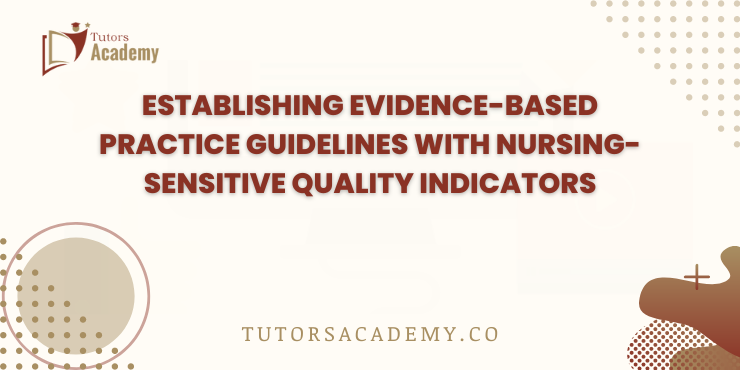
NURS FPX 4040 Assessment 4 Informatics and Nursing-Sensitive Quality Indicators
In the complicated healthcare setting, there is a high emphasis on hospital-acquired infection, utilization of nursing-sensitive quality indicators, and healthcare outcomes can be improved; as a result, the organization’s performance is improved. This analysis delves into the role of multi-disciplinary teams for research and reporting activities, enables data comparison using nursing-sensitive quality indicators to reveal gaps and room for improvement in healthcare delivery, and promulgates and strengthens evidence-based practice guidelines ( Rapin et al., 2022). Considering these essential factors, healthcare professionals can help advance the application of information-based awareness in improving systematic care delivery and organizational strategies.
Interdisciplinary Team’s Role in Data Collection and Reporting
The interdisciplinary team is critical in contributing to the quality indicator data, thus improving patient safety, care outcomes, and performance reports. Each team member represents particular expertise and views, which, in combination, allow for a detailed audit and analysis of healthcare quality.
Collaboration between various healthcare professionals, such as doctors, pharmacists, nurses, and allied health professionals, will be involved in filling out the health data collection form. The nurses, working as frontline providers, are the most likely to initiate data collection through patient assessment, registration of treatments, and timely observation of outcomes (Ernstmeyer & Christman, 2021). The doctors contribute by giving clinical insight and diagnosing issues, while pharmacists do the same by tracking medication-related permutations. The whole process is characterized by the interchanging of views and opinions, which enables the collection of diverse information that matters in this area.
The integrated mix of professionals looks at all sides of the data and the situation for comprehensive findings. With the nursing experience at the bedside, they contribute critical data regarding the patient experiences, care methods, and the various safety matters observed. Health practitioners evaluate, offer clinical acumen, and serve as diagnosticians, simplifying the comprehension of the case. The role of pharmacists nowadays is to evaluate medicine, ensure safety and efficiency, and find some events or medication errors. Because they can draw on knowledge from different disciplines and entities, the knowledge about components affecting the level of care becomes more in-depth.
Utilizing Nursing-Sensitive Quality Indicators for Enhanced Healthcare
The team’s interdisciplinary nature, collaboration in information generation, and accountability to the organization guarantee better organizational performance. Through tracking trends, patterns, and failures in implementation, the teams can launch more targeted approaches to improve the quality of health delivery. Consistent reviews and appraisal of quality indicators facilitate the quality improvement task force to track progress, assess the outcome of interventions, and make adjustments as required (Varela et al., 2023). To summarize, this forward-thinking attitude towards quality improvement encourages an environment where process learning and innovation are always present within the community.
NURS FPX 4040 Assessment 4 Informatics and Nursing-Sensitive Quality Indicators
Healthcare facilities implement nursing-sensitive performance metrics to improve patient care and safe treatment. The indicators in question, such as pressure ulcers, falls, medication errors, etc., show the improvement of patients’ vitality through nursing care. One way to do this is by measuring the indicators of health care quality such as patient satisfaction, communication, organizational practices, screening, referral, and follow-up; this can be used to see the areas of concern and, after that, implement the targeted interventions to address the risk areas and improve patient outcomes (Devasahay et al., 2021). For example, tracking skin breakdown rates will help the organization identify the patients prone to getting pressure ulcers. These patients will be given measures to prevent the formation of pressure ulcers, such as repositioning schedules and specialized support surfaces. This will then reduce the rates of pressure ulcers and enhance patients’ comfort and safety.
Nursing-sensitive quality indicators have a crucial role in organizations’ performance reporting. Nursing care quality impact, as well as the overall range of performance indicators being considered, is what is becoming visible through this type of reporting. The organizations that monitor and report on these indicators show transparency and accountability in the commitment to patient safety and the quality of care. Thus, they perform a crucial role in improving quality of care (Dreiher et al., 2020). By frequently conducting quality analysis of indicators, organizations are benchmarking their performance to know their industry competitors and suggest new ways to enhance performance. This forward-leaning prevention system for defining performance allows organizations to improve quality and safety and maximize organizational results continuously.

These QIs are the cornerstone of the RN-guided benchmarks based on scientific evidence and help nurses integrate all possible technologies in the care process for patient safety, satisfaction, and clinical outcomes. These indicators are the basis of robust data and increasingly evidence-based nursing care, including patient outcomes. Nurses can win the battle of evidence-based practices associated with improved outcomes with the help of indicator data such as reminder patient fall prevention strategies or an electronic way of drug administration, which reduces error (Garcia et al., 2021). These observations cornerstone the establishment of evidence-based recommendations to show nurses how to apply patient care technologies to ensure the quality of patient care.
Nursing-sensitive quality indicators are the source of discovering efficient care strategies, specifically, the role of nursing implementation in care delivery processes by incorporating patient care technology. Numerical indicators would allow nurses to spot the most effective interventions that show good patient outcomes and satisfaction rates. Tracking metrics concerning pain relief mechanisms may lead to discovering standardized regulations classified as using patient-controlled analgesia pumps or adapting electronic pain evaluators (Lovasi et al., 2023). Blending individual skills with evidence-based guidelines, the nurses are credentialed and provided with all the information and tools to properly utilize patient care technology to improve patient safety, satisfaction, and outcomes.
Nursing-sensitive quality indicators are abstract concepts that relate to the standardization of nursing practice and are measured by reference to clinical guidelines based on evidence. Such recommendations provide a framework of required standard application methods for patient care technologies proven efficient and outcome-oriented (Pereira et al., 2022). Evidence-based practice (EBP) is the adherence to established guidelines that guarantee the uniformity of patient care delivery, regardless of the environment or individualized practices. These standards offer a level playing field, ensuring continuity in patient care, assuring patient safety, and improving patient satisfaction and outcomes (Reig-Garcia et al., 2021). Using evidence-based guidelines, we have developed the framework for assessing an electronic patient care system’s effectiveness, facilitating continuous quality improvement processes, and adapting existing healthcare practices and technologies.
Conclusion
Incorporating nursing-sensitive quality measures into daily healthcare practice catalyzes a culture of perpetual enhancement that strives for further proficiencies. Collaborative work and objective decision-making processes based on evidence and not on intuition can help healthcare organizations maintain patient safety, satisfaction, and outcomes. These principles can guide the professionals in the healthcare community to a sensible approach to the complicated healthcare system, and the patients are expecting, and in most cases, getting every minute of the finest quality care.
Reference
Devasahay, S. R., DeBrun, D. A., Galligan, D. M., & McAuliffe, P. E. (2021). Key performance indicators that are used to establish concurrent validity while measuring team performance in hospital settings – A systematic review. Computer Methods and Programs in Biomedicine Update, 1(7), 100040.
https://doi.org/10.1016/j.cmpbup.2021.100040
Dreiher, D., Blagorazumnaya, O., Balicer, R., & Dreiher, J. (2020). National initiatives to promote quality of care and patient safety: Achievements to date and challenges ahead. Israel Journal of Health Policy Research, 9(1).
https://doi.org/10.1186/s13584-020-00417-x
Ernstmeyer, K., & Christman, E. (2021). Chapter 4 Nursing Process. Www.ncbi.nlm.nih.gov; Chippewa Valley Technical College.
https://www.ncbi.nlm.nih.gov/books/NBK591807/
Garcia, A., Bjarnadottir, R. (Raga) I., Keenan, G. M., & Macieira, T. G. R. (2021). Nurses’ perceptions of recommended fall prevention strategies. Journal of Nursing Care Quality, Publish Ahead of Print(3).
https://doi.org/10.1097/ncq.0000000000000605
Lau, B. D., Murphy, P., Nastasi, A. J., Seal, S., Kraus, P. S., Hobson, D. B., Shaffer, D. L., Holzmueller, C. G., Aboagye, J. K., Streiff, M. B., & Haut, E. R. (2020). Effectiveness of ambulation to prevent venous thromboembolism in patients admitted to hospital: A systematic review. CMAJ Open, 8(4), E832–E843.
https://doi.org/10.9778/cmajo.20200003
Lovasi, O., Lám, J., Frank, K., Schutzmann, R., & Gaál, P. (2023). The first comprehensive survey of the practice of postoperative pain management in Hungarian hospitals – a descriptive study. Pain Management Nursing, 4(8).
https://doi.org/10.1016/j.pmn.2022.12.001
Pereira, V. C., Silva, S. N., Carvalho, V. K. S., Zanghelini, F., & Barreto, J. O. M. (2022). Strategies for the implementation of clinical practice guidelines in public health: An overview of systematic reviews. Health Research Policy and Systems, 20(1).
https://doi.org/10.1186/s12961-022-00815-4
Rapin, J., Pellet, J., Mabire, C., Gendron, S., & Dubois, C.-A. (2022). How does nursing-sensitive indicator feedback with nursing or interprofessional teams work and shape nursing performance improvement systems? A rapid realist review. Systematic Reviews, 11(1), 1–17.
https://doi.org/10.1186/s13643-022-02026-y
Reig-Garcia, G., Suñer-Soler, R., Mantas-Jiménez, S., Bonmatí-Tomas, A., Malagón-Aguilera, M. C., Bosch-Farré, C., Gelabert-Viella, S., & Juvinyà-Canal, D. (2021). Assessing nurses’ satisfaction with continuity of care and the case management model as an indicator of quality of care in Spain. International Journal of Environmental Research and Public Health, 18(12), 6609.
https://doi.org/10.3390/ijerph18126609
Van Bulck, L., Goossens, E., Luyckx, K., Apers, S., Oechslin, E., Thomet, C., Budts, W., Enomoto, J., Sluman, M. A., Lu, C.-W., Jackson, J. L., Khairy, P., Cook, S. C., Chidambarathanu, S., Alday, L., Eriksen, K., Dellborg, M., Berghammer, M., Johansson, B., & Mackie, A. S. (2020). Healthcare system inputs and patient-reported outcomes: A study in adults with congenital heart defect from 15 countries. BMC Health Services Research, 20(1).
https://doi.org/10.1186/s12913-020-05361-9
Varela, T., Zamorano, P., Muñoz, P., Rain, C., Irazoqui, E., Sapag, J. C., & Tellez, A. (2023). Evaluation of the implementation progress through key performance indicators in Chile’s new multimorbidity patient-centred care model. BMC Health Services Research, 23(1).
https://doi.org/10.1186/s12913-023-09412-9
If you want to explore more information about this class assessment click below to view:
NURS FPX 4040 Assessment 2 Protected Health Information
